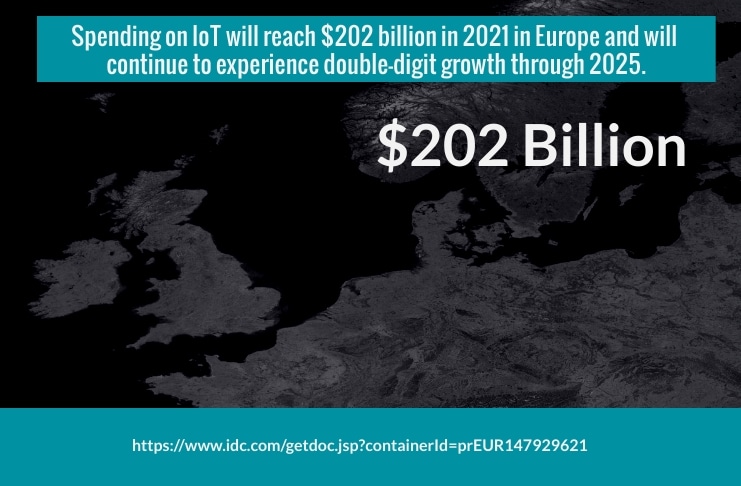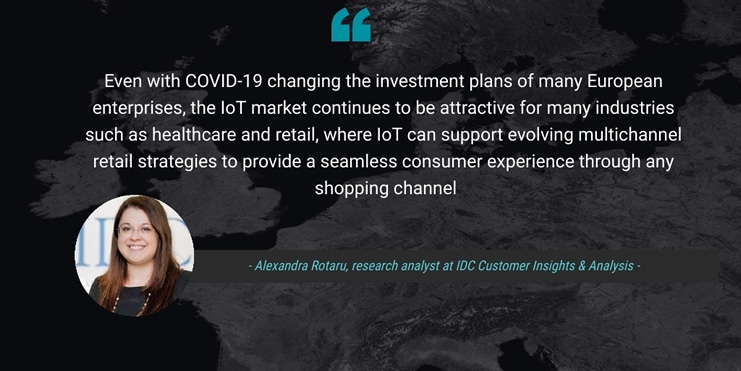The outlook for IoT spending across different industries will remain mixed for the coming years and depend a lot on the place/relevance of IoT use cases in the post-pandemic stages and requirements.
As per usual: whether it’s IoT or Industry 4.0, use cases should prevail – but with COVID-19, some priorities did change and occasionally accelerated with more significant contexts of digital transformation.
The same is, of course, valid for Europe, where, despite the pandemic, the IoT market experienced slight growth in 2020. For 2021, however, spending on IoT technology, solutions and services in Europe is forecast to reach $202 billion in 2021 (the first time over $200 billion). Moving forward, European IoT spending should continue to experience double-digit growth through 2025.

In general, the concept of ‘remoteness’ is vital in identifying which sectors will perform best in terms of IoT spending. Obviously, with IoT, Industrial IoT, Industry 4.0, and related technologies that show growth (think edge computing with edge spending expected to reach a total of $250 Billion in 2024), there is always a degree of remoteness.
Consumer sector largest industry, led by home automation solutions
Remote can mean many things. And that immediately shows in the consumer sector, poised to be the largest industry in Europe in 2021 from an IoT spending perspective, whereby home automation solutions take the lead.
Their aim: improve the living experience and, quoting IDC from the announcement of its latest forecast (announced in June 2021), “streamline everyday interactions to create a connected home environment in which consumers can remotely monitor and control, through apps or websites, their home systems, and home preferences/consumption.” In other words: remoteness and comfort at home for those who can afford it.
Manufacturing: data to prevent equipment failures
In the second-largest industry from an IoT spending viewpoint in Europe, manufacturing, the link with remote capabilities is crystal clear.
IoT in manufacturing was more impacted in 2020 by the pandemic. But the sector leveraged IoT solutions to, quote again, “remotely track, monitor, and maintain industrial manufacturing devices that are part of the production value chain by assessing equipment conditions and remotely diagnosing equipment failures before they happen.”
And that, of course, by analyzing the live stream of data produced by the machine. In other words: remoteness and continuity/operations/maintenance.
Healthcare and retail – IoT growers in Europe
IDC adds the third aspect of remoteness we’ve become accustomed to with, among others, social distancing and remote working in pointing out the fastest-growing European IoT spender.
No, not the world of work and offices/facilities, but healthcare where IoT usage in healthcare with remote health monitoring solutions (medical home monitoring) will be the fastest grower for years to come.

These aren’t the only industries and/or use cases that will do better, but you’ll have to get the report for the rest. Alexandra Rotaru, a research analyst at IDC Customer Insights & Analysis, gives additional takeaways with retail and IoT as just one area to watch.
Rotaru: “Even with COVID-19 changing the investment plans of many European enterprises, the IoT market continues to be attractive for many industries such as healthcare and retail, where IoT can support evolving multichannel retail strategies to provide a seamless consumer experience through any shopping channel”.
Which ones are expected to do worse in Europe? Rotaru: “Other verticals such as construction and personal and consumer services will see less demand and will develop more slowly in the coming years, focusing on supporting other business priorities in the post-crisis recovery process.”
The majority of IoT spending in Europe goes to hardware (modules and sensors), followed by services (IT and installation services, ongoing service such as operation of devices, etc.) and software.
However, software is the fastest grower as the need to leverage all that structured and unstructured data remains. Software includes analytics software, application software, horizontal, security, vertical industry, and other software. IDC: “The software category, especially application software for IoT used to organize and access a range of structured and unstructured information, will be the fastest-growing technology in the next few years.”
The findings on European IoT spending are part of IDC’s Worldwide Semiannual Internet of Things Spending Guide, which is updated twice per year and covers nine regions in total: United States, Canada, Japan, Western Europe, Central and Eastern Europe, Middle East and Africa, Latin America, PRC, and Asia/Pacific. For Europe, 22 countries (on a total of 53 worldwide) are covered.

